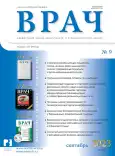Профилактика воздушно-капельной инфекции в операционных и стоматологических кабинетах: современные подходы и технологии
- Авторы: Брудян Г.С.1, Яриков А.В.2,3, Цыбусов С.Н.3, Соснин А.Г.4, Гарсия А.3
-
Учреждения:
- Воскресенская стоматологическая поликлиника
- Приволжский окружной медицинский центр Федерального медико-биологического агентства России
- Национальный исследовательский Нижегородский государственный университет им. Н.И. Лобачевского
- Приволжский исследовательский медицинский университет
- Выпуск: Том 34, № 9 (2023)
- Страницы: 86-91
- Раздел: Из практики
- URL: https://journals.eco-vector.com/0236-3054/article/view/604264
- DOI: https://doi.org/10.29296/25877305-2023-09-18
- ID: 604264
Цитировать
Полный текст
Аннотация
В современной медицинской практике вопросы асептики и дезинфекции в операционных и стоматологических кабинетах приобретают особую актуальность в контексте профилактики воздушно-капельных инфекций. Учитывая рост резистентности микроорганизмов к антибиотикам и увеличение числа инвазивных медицинских процедур, актуализируется необходимость в эффективных методах асептики и дезинфекции. Обзор охватывает современные подходы и технологии, направленные на минимизацию риска инфекционных осложнений. Рассматриваются методы вентиляции и фильтрации воздуха, применение ультрафиолетовой стерилизации и ламинарных потоков воздуха. Особое внимание уделяется их эффективности в различных медицинских отраслях, включая стоматологию и хирургию. Цель обзора – систематизация имеющихся знаний и формулирование рекомендаций для дальнейшего научного изучения и клинической практики.
Полный текст
Об авторах
Г. С. Брудян
Воскресенская стоматологическая поликлиника
Автор, ответственный за переписку.
Email: dr-brudyan@mail.ru
ORCID iD: 0009-0009-9434-8537
Россия, Воскресенск
А. В. Яриков
Приволжский окружной медицинский центр Федерального медико-биологического агентства России; Национальный исследовательский Нижегородский государственный университет им. Н.И. Лобачевского
Email: dr-brudyan@mail.ru
ORCID iD: 0000-0002-4437-4480
кандидат медицинских наук
Россия, Нижний Новгород; Нижний НовгородС. Н. Цыбусов
Национальный исследовательский Нижегородский государственный университет им. Н.И. Лобачевского
Email: dr-brudyan@mail.ru
доктор медицинских наук, профессор
Россия, Нижний НовгородА. Г. Соснин
Приволжский исследовательский медицинский университет
Email: dr-brudyan@mail.ru
кандидат медицинских наук
Россия, Нижний НовгородА. Гарсия
Национальный исследовательский Нижегородский государственный университет им. Н.И. Лобачевского
Email: dr-brudyan@mail.ru
кандидат медицинских наук
Россия, Нижний НовгородСписок литературы
- Royle R., Gillespie B.M., Chaboyer W. et al. The burden of surgical site infections in Australia: a cost-of-illness study. J Infect Public Health. 2023, 16: 792–8. doi: 10.1016/j.jiph.2023.03.018
- Wall R.T., Datta S., Dexter F. et al. Effectiveness and feasibility of an evidence-based intraoperative infection control program targeting improved basic measures: a post-implementation prospective case-cohort study. J Clin Anesth. 2022; 77: 110632. doi: 10.1016/j.jclinane.2021.110632
- CDC. The 2021 National and State Healthcare-Associated Infections Data Report. URL: https://www.cdc.gov/hai/data/portal/progress-report.html
- Healthcare-associated infections. URL: https://www.ecdc.europa.eu/en/healthcare-associated-infections
- Healthcare-associated infections acquired in intensive care units – Annual Epidemiological Report for 2019. URL: https://www.ecdc.europa.eu/en/publications-data/healthcare-associated-infections-intensive-care-units-2019
- Gidey K., Gidey M.T., Hailu B.Y. et al. Clinical and economic burden of healthcare-associated infections: A prospective cohort study. PLoS One. 2023; 18 (2): e0282141. doi: 10.1371/journal.pone.0282141
- Abubakar U., Amir O., Rodriguez-Baño J. Healthcare-associated infections in Africa: a systematic review and meta-analysis of point prevalence studies. J Pharm Policy and Pract. 2022; 15: 99. doi: 10.1186/s40545-022-00500-5
- Rong R., Lin L., Yang Y. et al. Trending prevalence of healthcare-associated infections in a tertiary hospital in China during the COVID-19 pandemic. BMC Infect Dis. 2023; 23 (1): 41. doi: 10.1186/s12879-022-07952-9
- Fayraq A., Alzahrani S.A., Alsayaf Alghamdi A.G. et al. Risk Factors for Post-appendectomy Surgical Site Infection in Laparoscopy and Laparotomy – Retrospective Cohort Study. Cureus. 2023; 15 (8): e44237. doi: 10.7759/cureus.44237
- Rushing C.J. (Lower Extremity Orthopedic Augmentation Utilizing a Synthetic Hybrid-Scale Fiber Matrix. Cureus. 2023; 15 (9): e45046. doi: 10.7759/cureus.45046
- Loftus R.W., Dexter F., Brown J.R. Transmission of Staphylococcus aureus in the anaesthesia work area has greater risk of association with development of surgical site infection when resistant to the prophylactic antibiotic administered for surgery. J Hosp Infect. 2023; 134: 121–8. doi: 10.1016/j.jhin.2023.01.007
- Dexter F., Loftus R.W. Bacterial transmission in anesthesia work areas explains surgical site infections. Infect Control Today. 2023; 27 (5): 8–9.
- Upendran A., Gupta R., Geiger Z. Dental Infection Control. [Updated 2023 Aug 8]. In: StatPearls [Internet]. Treasure Island (FL): StatPearls Publishing; 2023. URL: https://www.ncbi.nlm.nih.gov/books/NBK470356/
- Powell G.L., Runnells R.D., Saxon B.A. et al. The Presence and Identification of Organisms Transmitted to Dental Laboratories. J Prosthet Dent. 1990; 64: 235–7. doi: 10.1016/0022-3913(90)90185-f
- Erazo D., Whetstone D.R. Dental Infections. [Updated 2022 Sep 26]. In: StatPearls [Internet]. Treasure Island (FL): StatPearls Publishing; 2023. URL: https://www.ncbi.nlm.nih.gov/books/NBK542165/
- Communicable diseases in the dental surgery. URL: https://pocketdentistry.com/2-communicable-diseases-in-the-dental-surgery/
- Mohapatra S. Sterilization and Disinfection. Essentials of Neuroanesthesia. 2017; 929–44. doi: 10.1016/B978-0-12-805299-0.00059-2
Дополнительные файлы






